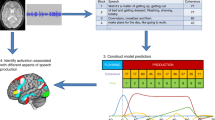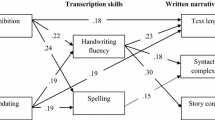Objective: To test the general hypothesis that schizophrenia patients have an executive deficit in speech production and the more specific hypothesis that this deficit is more severe when there is a greater demand on executive functions. Materials and methods: The study included 25 patients with schizophrenia and 27 healthy subjects (control group). All subjects took part in two tests: to tell stories based on a series of pictures and based on a specified theme. Results and conclusions: Schizophrenia patients displayed lower measures of programming and shorter texts and phrases than the control group in both tests. Patients’ subject-based stories included grammatical errors, along with the need for leading questions because of difficulties with plot construction; there was also greater dispersion of the length and syntactic complexity of the text. Thus, this study showed that during speech production, schizophrenia patients displayed a deficit of executive functions, which was most marked in the task involving a smaller number of external cues aiding speech planning and production.
Similar content being viewed by others
References
G. Orellana and A. Slachevsky, “Executive functioning in schizophrenia,” Front. Psychiatry, 4, 35 (2013), https://doi.org/10.3389/fpsyt.2013.00035.
A. Reichenberg and P. D. Harvey, “Neuropsychological impairments in schizophrenia: Integration of performance-based and brain imaging findings,” Psychol. Bull., 133, No. 5, 833–858 (2007), 10.1037/0033-2909.133.5.833.
G. Donohoe and I. H. Robertson, “Can specifi c defi cits in executive functioning explain the negative symptoms of schizophrenia? A review,” Neurocase, 9, No. 2, 97–108 (2003), https://doi.org/10.1076/neur.9.2.97.15075.
L. K. Clark, D. Warman, and P. H. Lysaker, “The relationships between schizophrenia symptom dimensions and executive functioning components,” Schizophr. Res., 124, No. 1–3, 169–175 (2010), https://doi.org/10.1016/j.schres.2010.08.004.
Y. Braw, A. Benozio, and Y. Levkovitz, “Executive functioning during full and partial remission (positive and negative symptomatic remission) of schizophrenia,” Schizophr. Res., 142, No. 1–3, 122–128 (2012), https://doi.org/10.1016/j.schres.2012.10.011.
F. Guillem, M. Rinaldi, T. Pampoulova, and E. Stip, “The complex relationships between executive functions and positive symptoms in schizophrenia,” Psychol. Med., 38, No. 6, 853–860 (2008), https://doi.org/10.1017/S0033291707002577.
J. Ventura, A. D. Thames, R. C. Wood, et al., “Disorganization and reality distortion in schizophrenia: a meta-analysis of the relationship between positive symptoms and neurocognitive deficits,” Schizophr. Res., 121, No. 1–3, 1–14 (2010), https://doi.org/10.1016/j.schres.2010.05.033.
D. Y. Yun, S. S. Hwang, Y. Kim, et al., “Impairments in executive functioning in patients with remitted and non-remitted schizophrenia,” Prog. Neuropsychopharmacol. Biol. Psychiatry, 35, No. 4, 1148–1154 (2011), https://doi.org/10.1016/j.pnpbp.2011.03.018.
D. M. Barch and A. Ceaser, “Cognition in schizophrenia: core psychological and neural mechanisms,” Trends Cogn. Sci., 16, No. 1, 27–34 (2012), https://doi.org/10.1016/j.tics.2011.11.015.
N. Rusch, I. Spoletini, M. Wilke, et al., “Prefrontal-thalamic-cerebellar gray matter networks and executive functioning in schizophrenia,” Schizophr. Res., 93, No. 1–3, 79–89 (2007), https://doi.org/10.1016/j.schres.2007.01.029.
A. R. Luriya, Language and Consciousness, Moscow University Press, Moscow (1979).
L. S. Vygotskii, The Theory and History of Psychology. Collected Works in Six Volumes, A. R. Luriya and M. G. Yaroshevskii (eds.), Pedagogikia, Moscow (1982).
L. S. Vygotskii, Thought and Speech, Labirint, Moscow (1999), 5th ed.
L. Cragg and K. Nation, “Language and the development of cognitive control,” Top. Cogn. Sci., 2, No. 4, 631–642 (2010), https://doi.org/10.1111/j.1756-8765.2009.01080.x.
D. M. Williams, D. M. Bowler, and C. Jarrold, “Inner speech is used to mediate short-term memory, but not planning, among intellectually high-functioning adults with autism spectrum disorder,” Dev. Psychopathol., 24, No. 1, 225–239 (2012), https://doi.org/10.1017/S0954579411000794.
Z. Shao, A. Roelofs, D. J. Acheson, and A. S. Meyer, “Electrophysiological evidence that inhibition supports lexical selection in picture naming,” Brain Res., 1586, 130–142 (2014), https://doi.org/10.1016/j.brainres.2014.07.009.
A. R. Luriya and A. R. Basic Problems in Neurolinguistics, Librodom, Moscow (2009), 3rd ed.
J. Smallwood, K. Brown, B. Baird, and J. W. Schooler, “Cooperation between the default mode network and the frontal-parietal network in the production of an internal train of thought,” Brain Res., 1428, 60–70 (2012), https://doi.org/10.1016/j.brainres.2011.03.072.
M. P. Alexander, D. F. Benson, and D. T. Stuss, “Frontal lobes and language,” Brain Lang., 37, No. 4, 656–691 (1989), https://doi.org/10.1016/0093-934x(89)90118-1.
A. Blackwell and E. Bates, “Inducing agrammatic profiles in normals: Evidence for the selective vulnerability of morphology under cognitive resource limitation,” J. Cogn. Neurosci., 7, No. 2, 228–257 (1995), https://doi.org/10.1162/jocn.1995.7.2.228.
M. C. Silveri, M. G. Leggio, and M. Molinari, “The cerebellum contributes to linguistic production: a case of agrammatic speech following a right cerebellar lesion,” Neurology, 44, No. 11, 2047–2050 (1994), https://doi.org/10.1212/wnl.44.11.2047.
A. R. Luriya, Basic Neuropsychology, Academy Publishing Center, Moscow (2003).
Z. Ye and X. Zhou, “Executive control in language processing,” Neurosci. Biobehav. Rev., 33, No. 8, 1168–1177 (2009), https://doi.org/10.1016/j.neubiorev.2009.03.003.
G. Arcara and V. Bambini, “A test for the assessment of pragmatic abilities and cognitive substrates (APACS, normative data and psychometric properties,” Front. Psychol., 7, 70 (2016), https://doi.org/10.3389/fpsyg.2016.00070.
V. Cardella, Language and Schizophrenia: Perspectives from Psychology and Philosophy, Routledge (Taylor & Francis group), London and New York (2018).
V. C. Zimmerer, S. Watson, D. Turkington, et al., “Deictic and propositional meaning-new perspectives on language in schizophrenia,” Front. Psychiatry, 8, 17 (2017), https://doi.org/10.3389/fpsyt.2017.00017.
T. J. Crow, “Is schizophrenia the price that Homo sapiens pays for language?” Schizophr. Res., 28, No. 2–3, 127–141 (1997), https://doi.org/10.1016/s0920-9964(97)00110-2.
W. Hinzen and J. Rossello, “The linguistics of schizophrenia: thought disturbance as language pathology across positive symptoms,” Front. Psychol., 6, 971 (2015), https://doi.org/10.3389/fpsyg.2015.00971.
R. P. Bentall, “The illusion of reality: a review and integration of psychological research on hallucinations,” Psychol. Bull., 107, No. 1, 82–95 (1990), 10.1037/0033-2909.107.1.82.
I. Feinberg, “Efference copy and corollary discharge: implications for thinking and its disorders,” Schizophr. Bull., 4, No. 4, 636–640 (1978), https://doi.org/10.1093/schbul/4.4.636.
C. D. Frith, The Cognitive Neuropsychology of Schizophrenia, Psychology Press, London (1992).
A. B. Smulevich, D. V. Romanov, E. I. Voronova, et al., “Evolution of the concept of schizophrenic deficit,” Zh. Nevrol. Psikhiatr., 117, No. 9, 4–14 (2017), 10.17116/jnevro2017117914-14.
A. N. Barkhatova, “Prognostic value of the psychopathological structure of remission at the initial stage of schizophrenia,” Zh. Nevrol. Psikhiatr., 119, No. 3, 5–11 (2019).
V. Rapcan, S. D’Arcy, S. Yeap, et al., “Acoustic and temporal analysis of speech: A potential biomarker for schizophrenia,” Med. Eng. Phys., 32, No. 9, 1074–1079 (2010), https://doi.org/10.1016/j.medengphy.2010.07.013.
G. Fervaha, H. Takeuchi, G. Foussias, et al., “Using poverty of speech as a case study to explore the overlap between negative symptoms and cognitive dysfunction,” Schizophr. Res., 176, No. 2–3, 411–416 (2016), https://doi.org/10.1016/j.schres.2016.05.019.
R. Morice, “Beyond language – speculations on the prefrontal cortex and schizophrenia,” Aust. N. Z. J. Psychiatry, 20, No. 1, 7–10 (1986), https://doi.org/10.3109/00048678609158859.
K. King, W. I. Fraser, P. Thomas, and R. E. Kendell, “Re-examination of the language of psychotic subjects,” Br. J. Psychiatry, 156, 211–215 (1990), https://doi.org/10.1192/bjp.156.2.211.
P. Thomas, K. King, W. I. Fraser, and R. E. Kendell, “Linguistic performance in schizophrenia: a comparison of acute and chronic patients,” Br. J. Psychiatry, 156, 204–210, 214–215 (1990), https://doi.org/10.1192/bjp.156.2.204.
R. Morice and D. McNicol, “The comprehension and production of complex syntax in schizophrenia,” Cortex, 21, No. 4, 567–580 (1985), https://doi.org/10.1016/s0010-9452(58)80005-2.
W. I. Fraser, K. M. King, P. Thomas, and R. E. Kendell, “The diagnosis of schizophrenia by language analysis,” Br. J. Psychiatry, 148, 275–278 (1986), https://doi.org/10.1192/bjp.148.3.275.
R. D. Morice and J. C. L. Ingram, “Language complexity and age of onset of schizophrenia,” Psychiatry Res., 9, No. 3, 233–242 (1983), 10.1016/0165-1781(83)90048-3.
T. V. Akhutina, Neurolinguistic Analysis of Dynamic Aphasia. Mechanisms of Sentence Construction, Terevinf, Moscow (2002), 2nd ed.
J. M. Fuster, “Executive frontal functions,” Exp. Brain Res., 133, No. 1, 66–70 (2000), https://doi.org/10.1007/s002210000401.
T. V. Akhutina, Neurolinguistic Analysis of the Lexicon, Semantics, and Pragmatics, Languages of Slavic Culture, Moscow (2014).
I. Martin and S. McDonald, “Weak coherence, no theory of mind, or executive dysfunction? Solving the puzzle of pragmatic language disorders,” Brain Lang., 85, No. 3, 451–466 (2003), https://doi.org/10.1016/s0093-934x(03)00070-1.
T. V. Akhutina, “The role of the right hemisphere in text construction,” Psikholingvistika, 3, 10–28 (2009).
B. I. Belyi, Characteristics of the Interpretation of Narrative Pictures by Patients with Tumors of the Left and Right Hemispheres. Neuropsychological Analysis of Interhemisphere Asymmetry of the Brain, Nauka, Moscow (1986).
S. R. Kay, A. Fiszbein, and L. A. Opler, “The positive and negative syndrome scale (PANSS) for schizophrenia,” Schizophr. Bull., 13, No. 2, 261–276 (1987), https://doi.org/10.1093/schbul/13.2.261.
T. A. Fotekova and T. V. Akhutina, Diagnosis of Speech Impairments in Schoolchildren Using Neuropsychological Methods, ARKTI, Moscow (2002).
T. V. Akhutinaya and O. B. Inshakovaya (eds.), Neuropsychological Diagnosis and Reading and Writing Studies in Young Schoolchildren, V. Sekachev, Moscow (2014).
J. Addington and D. Addington, “Premorbid functioning, cognitive functioning, symptoms and outcome in schizophrenia,” J. Psychiatry Neurosci., 18, No. 1, 18–23 (1993).
D. S. O’Leary, M. Flaum, M. L. Kesler, et al., “Cognitive correlates of the negative, disorganized, and psychotic symptom dimensions of schizophrenia,” J. Neuropsychiatry Clin. Neurosci., 12, No. 1, 4–15 (2000), https://doi.org/10.1176/jnp.12.1.4.
E. Bora, S. Gokcen, B. Kayahan, and B. Veznedaroglu, “Deficits of social-cognitive and social-perceptual aspects of theory of mind in remitted patients with schizophrenia: effect of residual symptoms,” J. Nerv. Ment. Dis., 196, No. 2, 95–99 (2008), https://doi.org/10.1097/NMD.0b013e318162a9e1.
Yu. O. Filimonenko and V. I. Timofeev, Guidelines for Wechsler Studies of Intelligence for Adults, Adaptation, St. Petersburg (1995).
V. L. Deglin, Paradoxical Aspects of Human Thought. Neuropsychological Analysis, St. Petersburg (1996).
Author information
Authors and Affiliations
Corresponding author
Additional information
Translated from Zhurnal Nevrologii i Psikhiatrii imeni S. S. Korsakova, Vol. 120, No. 8, Iss. 1, pp. 14–22, August, 2020.
Rights and permissions
About this article
Cite this article
Panikratova, Y.R., Vlasova, R.M., Akhutina, T.V. et al. Executive Regulation of Speech Production in Schizophrenia: A Pilot Neuropsychological Study. Neurosci Behav Physi 51, 415–422 (2021). https://doi.org/10.1007/s11055-021-01086-2
Received:
Accepted:
Published:
Issue Date:
DOI: https://doi.org/10.1007/s11055-021-01086-2




